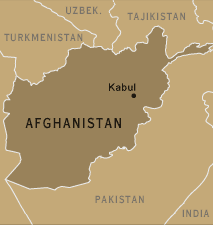
1. Constitutional History
Afghanistan’s most recent constitution was ratified in 2004. The country’s prior constitution was drafted in 1990.
2. Type of Government
Afghanistan is currently under a transitional government. Under the new constitution the country will be a republic. The interim president, who is both chief of state and head of government is Hamid Karzai; under the new constitution the president and two vice presidents will be elected by direct vote for a five-year term. Currently the legistlative branch of the Afghan government is nonfunctioning; under the new constitution the bicameral national assembly will consist of the Wolesi Jirga (House of People) and the Meshrano Jirga (House of Elders). The new constitution establishes a nine-member supreme court (Stera Mahkama).
3. Process for Drafting and Ratification
The transitional authority participated in a constitutional loya jirga in late 2003, which culminated in approval of a new constitution that was signed into law on January 26, 2004.
4. Assistance From International Agencies
The U.N. International Security Assistance Force (ISAF) in Afghanistan is not a U.N. peacekeeping operation but has allowed the U.N. to assert significant influence over the development of Afghanistan after the fall of the Taliban.
In 1979 Afghanistan was invaded by the Soviet Union. Ten years later, anti communist forces (including the United States) helped mujahedin fighters expel the Soviets. This conflict gave way to internal strife as rival factions within Afghanistan fought each other for control. The Taliban emerged as the most powerful of these and seized command of the country in 1996. After the Taliban were implicated as responsible for the September 11th attacks in the United States, the U.S. and allied forces invaded Afghanistan and succeeded in toppling the Taliban. This event presented the Afghans with their first real opportunity for sovereignty. In an effort to embrace that opportunity Afghan leaders of various Taliban opposition groups met in Bonn, Germany in late 2001 and designed a plan for implementing a new government for Afghanistan. This plan included drafting a new constitution and establishing an interim government meant to guide the country from its war-ravaged state into a position of peace and self-rule.
Afghanistan’s history of internal disquietude continues now, as its many different ethnic groups, tribal leaders, emerging political parties, and warlords vie for influence. Of course, in addition to the internal struggle to keep the peace and stick to the terms of the Bonn Agreement for reconstruction, Afghans endure continuing military action meant to expel remaining terrorists, crippling poverty, an annihilated infrastructure, a rapidly growing drug trade, lack of educational opportunities, and extensive land mines as impediments to their quest for peace and national stability.
The new constitution mirrors the constitution of the United States in many ways: its president will serve both as head of government and chief of state, and the afghan national assembly will consist, like the U.S. Congress, of two primarily elected bodies. However, Afghanistan’s constitution does not separate church and state as the United States does. Instead, the constitution defines the country as an Islamic nation formally called the Islamic Republic of Afghanistan. The next task Afghanistan’s fledgling government faces is to hold nationwide elections. Successful completion of national elections is the one major step left to complete before the transitional authority would dissolve, and the country would officially become a self-governing republic.
- Previous: Introduction
- Next: Venezuela


